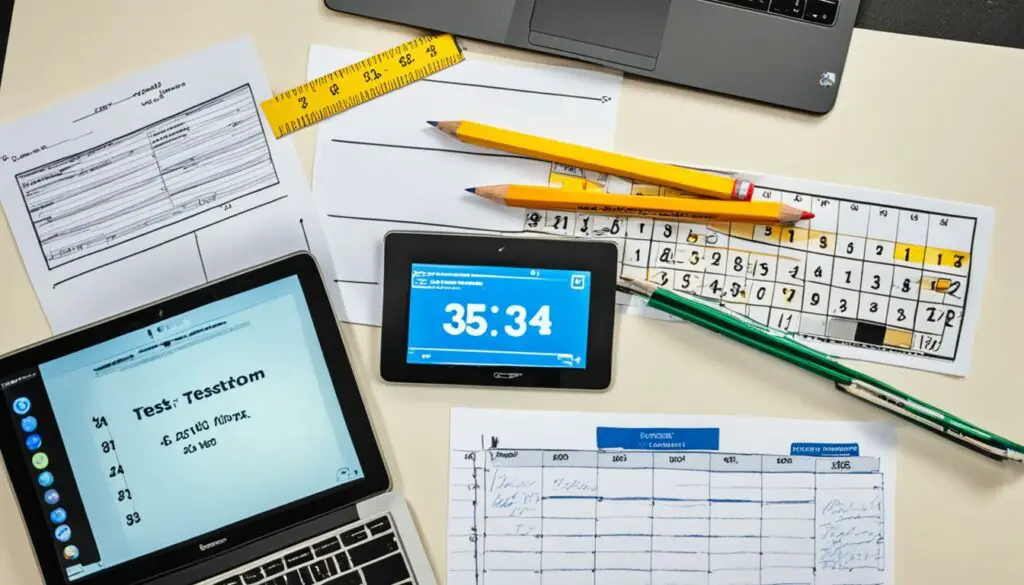LSAT Flex vs LSAT: Key Differences Compared
Have you heard about the LSAT Flex and wondered how it compares to the traditional LSAT? Are you curious about the differences between the two tests and how they may affect your preparation and scores? If so, you’re in the right place.
The Fourth Experimental Section
The LSAT Flex includes a fourth experimental section that is not scored. This section allows LSAC to pre-test questions with test-takers to determine their difficulty level and potential inclusion in future scored sections.
The experimental section appears randomly on test day and looks like one of the three existing sections (Logic Games, Logical Reasoning, or Reading Comprehension).
Testing Question Validity
This process involves presenting test-takers with new and untested questions, collecting performance data, and analyzing the results to assess the difficulty level and effectiveness of the questions.
Questions that demonstrate suitable performance characteristics may be considered for inclusion in future scored sections of the LSAT.
An Indistinguishable Section
During the LSAT Flex, the experimental section can appear as one of the three existing sections, indistinguishable from the scored sections.
This design prevents test-takers from determining which section is experimental and forces them to focus on solving the questions to the best of their abilities. It also ensures that test-takers approach each section with equal dedication and effort.
Focus on Question Solving
While the experimental section may be challenging, test-takers must concentrate on answering the questions rather than trying to identify which section is experimental. Devoting time and attention to solving the questions accurately and efficiently will yield the best results.
Test Format and Scoring
The LSAT Flex retains the same format as the traditional LSAT, comprising three sections: Logic Games (Analytical Reasoning), Reading Comprehension, and Logical Reasoning. Each section lasts 35 minutes. The scoring system and difficulty level remain consistent between the LSAT Flex and the traditional LSAT.
The scoring range for both tests is identical, with a maximum score of 180. However, slight variations may occur in the conversion of raw scores to scaled scores due to the absence of one section in the LSAT Flex.
Understanding the LSAT Flex format is crucial for test-takers to prepare effectively. Below is a breakdown of the test format:
🌟 Hey Students! 🚀 Ready for the ultimate experience? Join us on Studentsinside.com's Facebook, YouTube, WhatsApp, and LinkedIn. Click now for tips, fun, and success vibes! 🌈✨ #StudentLife #JoinUs
Test Format:
-
- Logic Games (Analytical Reasoning):
The Logic Games section assesses the test-taker’s ability to analyze and draw conclusions from a set of conditions. It typically consists of four sets of logic puzzles, each with five to seven questions.
-
- Reading Comprehension:
The Reading Comprehension section evaluates the test-taker’s ability to understand and analyze complex passages. It includes four reading passages, with five to eight questions per passage.
-
- Logical Reasoning:
The Logical Reasoning section measures the test-taker’s ability to evaluate arguments, identify flaws in reasoning, and make logical deductions. It comprises two short passages with about 25 questions per set.
| Section | Format | Duration |
|---|---|---|
| Logic Games (Analytical Reasoning) | Analyze and draw conclusions from logic puzzles | 35 minutes |
| Reading Comprehension | Understand and analyze complex passages | 35 minutes |
| Logical Reasoning | Evaluate arguments, identify flaws, and make deductions | 35 minutes |
Test Day Experience
LSAT Flex test-takers undergo a well-structured sequence of sections on test day, ensuring a smooth and efficient testing experience.
LSAT Flex Order of Sections
The order of the LSAT Flex sections is randomized, keeping test-takers on their toes and eliminating any predictability. The three main sections, Logic Games, Logical Reasoning, and Reading Comprehension, may appear in any order.
Test Duration and Break Time
The LSAT Flex, including break time, lasts approximately two hours and 45 minutes. Here’s a breakdown of the test day timeline:
| Section | Duration |
|---|---|
| First Section | 35 minutes |
| Second Section | 35 minutes |
| 10-Minute Break | – |
| Third Section (Includes the Experimental Section) | 35 minutes |
| Final Section | 35 minutes |
Preparation for the LSAT Flex
To adequately prepare for the LSAT Flex, it is crucial to simulate the testing experience and become familiar with its unique format and requirements. Here are some essential tips and strategies to help you prepare effectively:
1. Simulate the Testing Experience
To ensure a successful LSAT Flex performance, including extra sections in your practice exams is highly recommended. This will help you adapt to the extended testing time and build endurance. It is also beneficial to rotate the type of “extra” section used, emulating the unpredictable nature of the LSAT Flex.
2. Practice with LSAT Flex Format
Practice with practice tests replicating the online LSAT format, such as LSAC’s LawHub. These practice tests will familiarize you with the online interface, timer, and overall test experience.
Taking full-length practice tests, including an extra unscored section, will acclimate you to the online format and help you manage your time effectively.
3. Create a Suitable Study Environment
Studying in the same room where you plan to take the LSAT Flex can help establish familiarity and reduce test-day nerves. Additionally, ensure you have a strong and stable internet connection to avoid technical difficulties during the exam.
4. Develop Effective Study Strategies
- Understand the LSAT question types and format: Familiarize yourself with the different questions, such as Logical Reasoning, Logic Games, and Reading Comprehension. Understand the specific requirements of each section and develop effective strategies for tackling the different question types.
- Review study materials: Use reputable LSAT prep resources, such as official LSAT practice tests, study guides, and online courses, to enhance your understanding of the exam content and format.
- Practice time management: Time management is crucial in the LSAT Flex. Practice answering questions within the designated time limits to improve speed and accuracy.
- Analyze your practice tests: After completing practice tests, thoroughly analyze your performance. Identify your strengths and weaknesses, and focus on improving areas where you struggle.
- Seek additional support if needed: If you need extra guidance and support, consider enrolling in LSAT prep courses or working with a tutor. These resources can provide valuable insights and strategies to boost your performance.
Now let’s take a look at a table that summarizes the key preparation tips for the LSAT Flex:
| Preparation Tips for the LSAT Flex |
|---|
| Simulate the testing experience by including extra sections in practice exams |
| Practice with LSAT Flex format using official practice tests and LSAC’s LawHub |
| Study in the same room as test day and ensure a strong internet connection |
| Understand LSAT question types and develop effective strategies |
| Review study materials and utilize reputable LSAT prep resources |
| Practice time management to improve speed and accuracy |
| Analyze practice test results and focus on areas of improvement |
| Consider additional support through LSAT prep courses or tutors |
Admissions Considerations
Law schools recognize the LSAT Flex as a legitimate and accurate measure of a candidate’s aptitude for legal studies. The LSAT Flex score is considered on par with scores from the traditional LSAT and LSAT-Flex administrations.
Admissions committees give significant weight to LSAT scores when assessing applicants’ qualifications for law school admission. The scaled score ranges from 120 to 180 and serves as a standardized measure of a test-taker’s performance.
LSAT Registration
LSAT administrations are held from August 2021 to June 2022, and registration is now open. Test-takers can easily register for upcoming test dates through their LSAC (Law School Admission Council) online account.
To register for the LSAT, follow these steps:
- Log in to your LSAC online account.
- Click on the “LSAT” tab.
- Choose your preferred test date from the available options.
- Complete the registration form and submit payment.
Registering early is vital to securing your desired test date and location. Don’t wait until the last minute, as test dates can fill up quickly. Remember the LSAT registration deadlines to avoid missing your preferred test date.
The LSAT registration fee for the 2023-2024 testing year is $222. The fee covers the test administration and other services provided by LSAC.
Visit the LSAC website for detailed information on LSAT test dates and registration deadlines. Choosing a test date that aligns with your schedule and allows ample time for preparation.
Review the registration process thoroughly and gather all the necessary documents and information before initiating the registration. This will ensure a smooth and streamlined registration experience.
| Testing Year | Registration Fee |
|---|---|
| 2023-2024 | $222 |
Test Day Options
Starting with the August 2023 LSAT, test-takers have multiple options for their test day experience. The Law School Admission Council (LSAC) introduced these options in response to test-taker feedback, providing greater flexibility and convenience. Test-takers can select the option that best suits their individual preferences and circumstances.
LSAT at Home
One of the test day options is taking the LSAT at home, proctored by a live remote proctor. This option allows test-takers to complete the LSAT in the comfort of their own space, eliminating the need to travel to a testing center.
The LSAT at-home option requires a reliable internet connection, a quiet and well-lit room, and compliance with LSAC’s remote proctoring guidelines. Test-takers should ensure their testing area meets the technical requirements and follow the LSAC’s guidelines for test day procedures.
LSAT In-Person Testing
The LSAC offers the option to take the LSAT at a Prometric digital testing center for test-takers who prefer a traditional in-person testing environment. These centers provide a controlled and secure environment for conducting the exam.
Test-takers will have access to the necessary resources, such as scratch paper and pencils, per LSAC rules and regulations. It is important to note that the availability of in-person testing centers may vary depending on the test date and location.
Comparison of Test Day Options
Here is a comparison of the key features and considerations for each test day option:
Scheduling and Test Center Options
Test-takers can choose the day and time of their LSAT test, whether they opt for online remote testing or an in-person test center. Scheduling options ensure convenience and allow test-takers to tailor their test experience to their preferences.
In-Person Test Center Scheduling
For test-takers who prefer an in-person testing environment, scheduling for test centers opens 37 days before the administration date.
It is important to note that test-takers have a 7-day window to schedule their test once the registration period opens. To secure their preferred testing date and time, test-takers should schedule early to avoid scheduling conflicts.
Online Remote Testing Scheduling
Online remote testing offers the convenience of taking the LSAT from the comfort of your own home. Scheduling for online remote testing also opens 37 days before the administration date.
However, it is crucial to know that the scheduling deadline for online remote testing is three days before testing begins. Test-takers should take note of this deadline and schedule their test accordingly to ensure smooth planning and preparation.
Regardless of the chosen testing option, planning and scheduling early are key to securing the desired testing time and test center. Now, let’s examine the different considerations when deciding between LSAT remote testing and in-person test centers.
LSAT Remote Testing
LSAT remote testing offers flexibility, convenience, and the ability to take the test from the comfort of your home. It eliminates the need to travel to a test center, making it an appealing option for those who prefer a familiar environment and minimal disruptions. Test-takers can complete the LSAT remotely using their computer with a live remote proctor monitoring the exam.
In-Person Test Center
For those who prefer a traditional testing environment, an in-person test center provides a dedicated space for taking the LSAT. It provides a controlled setting with proctors to oversee the exam and ensure fairness and security. Test-takers can focus solely on the exam without distractions or technical concerns.
When selecting an in-person test center, consider location, accessibility, and necessary accommodations. Choosing a convenient test center that is convenient and conducive to a comfortable testing experience is essential.
Now, let’s summarize the scheduling and test center options in the following table:
| Options | Timing | Registration Deadline |
|---|---|---|
| In-Person Test Center | Opens 37 days before the administration date | Seven days before the testing date |
| Online Remote Testing | Opens 37 days before the administration date | Three days before testing begins |
Test Administration Changes
Given that the deadline for test date changes has not passed, test-takers have the option to make changes to their LSAT test administration. These changes can be made through the LSAT Status page of their LSAC online account. However, it is important to note that additional fees may apply.
One key change that test-takers can make is switching from in-person testing to online remote testing or vice versa, depending on availability and specific accommodations requirements. This flexibility provides test-takers with options that best suit their needs and preferences.
Change your LSAT Test Administration
Follow these steps to change your LSAT test administration:
- Log in to your LSAC online account.
- Navigate to the LSAT Status page.
- Review the available test administration options.
- Select the desired test administration.
- Confirm the changes and proceed with any necessary payment, if applicable.

Test Limits and Retakes
These guidelines ensure fairness and consistency in the administration and scoring of the exam.
According to the LSAC, test-takers can take the LSAT five times within the current reportable score period, which began in June 2018. Additionally, test-takers are permitted to take the LSAT seven times over a lifetime. It is important to note that canceled LSAT scores and absences do not count toward these limits.
However, retaking the LSAT is restricted to individuals who have previously achieved a perfect score of 180 within the current reportable score period. If a test-taker has already attained a perfect score during this period, they cannot retake the exam.
In certain circumstances, test-takers may have special circumstances that warrant an exception to the test limit policy. In such cases, individuals can submit an appeal to the LSAC, providing relevant documentation and a detailed explanation of why they require an exception to the test limit policy.
LSAT Retake Limits Summary:
| Test Limit | Current Reportable Score Period | Lifetime | Exception |
|---|---|---|---|
| Maximum Number of Attempts | 5 | 7 | May, June, July, and August 2020 LSAT-Flex tests |
| Perfect Score (180) | Restricts further retakes within the current reportable score period | N/A | N/A |
| Cancelled Scores and Absences | Do not count towards the limits | Do not count towards the limits | Do not count towards the limits |
Understanding LSAT Scores
LSAT score reports provide valuable insights into a test-taker’s performance. These reports include essential information, such as the scaled score, percentiles, and score conversion. The scaled score is determined by the number of correct answers on the LSAT, clearly representing the test-taker’s performance.
Furthermore, LSAT score reports showcase up to 12 recent scores from previous attempts within the last five years. This comprehensive overview allows test-takers to track their progress and identify areas for improvement. Additionally, the score report includes a score band that estimates proficiency within a range of results, giving a comprehensive understanding of performance levels.
FAQ
What are the key differences between the LSAT Flex and the LSAT?
The LSAT Flex introduced a fourth experimental section and removed the writing section. The format, scoring, and difficulty level remain the same as the traditional LSAT.
What is the purpose of the fourth experimental section in the LSAT Flex?
The fourth experimental section allows LSAC to pre-test questions and validate future scored sections.
What is the test format and scoring for the LSAT Flex?
The LSAT Flex has three sections (Logic Games, Reading Comprehension, and Logical Reasoning), each 35 minutes long. The scoring system and difficulty level are unchanged, with a maximum score of 180.
How is the test day experience for the LSAT Flex?
Test-takers complete two sections back-to-back, followed by a 10-minute break, and then the remaining two sections back-to-back. The order of the sections, including the placement of the experimental section, is random.
How should I prepare for the LSAT Flex?
It is recommended that the testing experience be simulated, that practice with online LSAT-format practice tests, and that study in the same room as test day with a strong internet connection.
How are LSAT Flex scores considered in law school admissions?
The LSAT Flex is considered a valid LSAT for admissions purposes, and admissions professionals consider scores equivalent to previous LSAT scores.
How do I register for the LSAT?
Test-takers can register for upcoming test dates through their LSAC online account. Test dates and registration deadlines are also available on the LSAC website.
What are the test day options for the LSAT?
Starting in August 2023, test-takers can choose between taking the test at home, having it proctored by a live remote proctor, or taking it at a Prometric digital testing center.
How do I schedule my LSAT test?
Scheduling for in-person test centers opens 37 days before the administration date, while scheduling for online remote testing opens 37 days before and closes three days before testing begins.
Can I change my LSAT test administration?
Test-takers can change their test administration as long as the deadline for test date changes has not passed. Changes can be made through the LSAT Status page of the LSAC online account, with additional fees if applicable.
What are the test limits and retake policies for the LSAT?
Test-takers can take the LSAT five times within the current reportable score period (since June 2018) and seven times over a lifetime. There are exceptions for LSAT-Flex tests taken between May and August 2020.
How are LSAT scores reported and interpreted?
LSAT score reports provide information on test-takers scaled scores, percentiles, score conversions, recent scores, and score bands. The LSAT Writing Exam is required to receive the score report.








